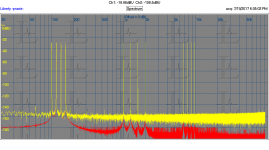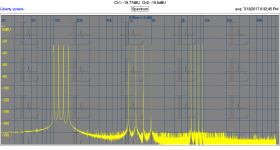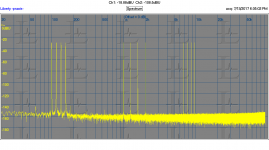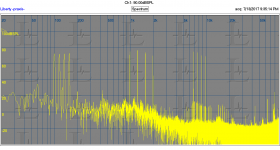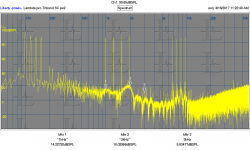The wife in the kitchen trope lives on!!!!!
Isn't the string vibration the sound in the first place? Yes it is amusing, it must be the posh kitchen.
So I take it you found significant electric fields, not just the magnetic field measurements you were talking about earlier?
Also, how are you grounding your shields, at both ends, or which end?
there are both to be measured..... don't recall exact numbers.... just remember how far the magnetic field radiated was impressive. But I use braided shield sleeve slipped over the wires and ground at one end.
I have also used coax cable for speaker cables... several in parallel. Seems to help also
THx-RNMarsh
This is how we get listening re-enforcement.
It was interesting as this type story has been told for generations. But, still true. Meets the No looking test and not even knowing anything was changed, heard significant improvements first time played..... as did myself.
The BenchMark DAC 3 booklet with the product tells what they did differently and why its now better. Very good reading. Reasons why CD/digital hasn't sounded right. But now sounds best I've heard in my system so far..... VERY good.
Meanwhile, talking to Audio precision --- Talking about the multi-tone testing of an entire system.... How high would the 'grass' grow. It was mentioned that every other bin has no data and only noise and in multi-tones you can also see the noise in the gear or system raise.... especially at higher signal levels. I presume this is because the currents thru devices are no longer at their lowest (idle) noise levels. So, there is a dynamic noise level increase that is easily seen with the A-P multi-tone system. [double sampling rate leaves every other bin open for noise].
This is an area where I will be testing next as I suspect this continuously testing of one piece of gear in isolation is Fake data. We will find the grass grows very tall... well into audible levels and causes loss of details in sound that we can hear.
I wish some over in the equipment forum will make us a 30-60 multi-tone PC based system that is PnP. Then we can all reduce the use of THD and two tone IM in favor of the multi-tone. And not have to buy an A-P ($$$) to do what ought to be thee distortion test for all gear because we get all the harmonics and all the IM products of all the freqs in one test which shows the total magnitude of the distortion. Better correlation to music and listening results?
THx-RNMarsh
Last edited:
Well I have been a big fan of multi-tone for a while.
In terms of screening mains leads. How do you avoid the 'conduit transformer' problem (https://centralindianaaes.files.wordpress.com/2012/09/indy-aes-2012-seminar-w-notes-v1-0.pdf page 33) that Bill Whitlock claims to be the biggest cause of 60Hz harmonic injection?
In terms of screening mains leads. How do you avoid the 'conduit transformer' problem (https://centralindianaaes.files.wordpress.com/2012/09/indy-aes-2012-seminar-w-notes-v1-0.pdf page 33) that Bill Whitlock claims to be the biggest cause of 60Hz harmonic injection?
Well I have been a big fan of multi-tone for a while.
In terms of screening mains leads. How do you avoid the 'conduit transformer' problem (https://centralindianaaes.files.wordpress.com/2012/09/indy-aes-2012-seminar-w-notes-v1-0.pdf page 33) that Bill Whitlock claims to be the biggest cause of 60Hz harmonic injection?
Not using a ground pin on some gear...... and on others -- DAC and CD player are on separate ac-line isolation transformers. My own design of isolation and filtering combo.
No ground loops with shields.
-RM
Last edited:
Here you go. Three band set of spectral contamination tones. The tones are selected to have both IM products and harmonic products not land on other tones. New IM Test Signals
First picture- composite of digital and analog overlaid. Second is digital loopback (essentially best possible in perfect world with 24bit 192KHz sample rate and 1M point FFT.) Third is analog loopback through an RTX6001. The noise floor is the limitation. It seems pretty free of any IM products or artifacts.
I can provide a digital file if someone has a place to upload it to. I use this with speakers. You see both response issues and distortion products. The noise floor is nowhere near that low with acoustic measurements.
(Kudo's to Jens on his RTX6001. Its really good and would probably make for a really good DAC. DIY Audio Analyzer with AK5397/AK5394A and AK4490 )
First picture- composite of digital and analog overlaid. Second is digital loopback (essentially best possible in perfect world with 24bit 192KHz sample rate and 1M point FFT.) Third is analog loopback through an RTX6001. The noise floor is the limitation. It seems pretty free of any IM products or artifacts.
I can provide a digital file if someone has a place to upload it to. I use this with speakers. You see both response issues and distortion products. The noise floor is nowhere near that low with acoustic measurements.
(Kudo's to Jens on his RTX6001. Its really good and would probably make for a really good DAC. DIY Audio Analyzer with AK5397/AK5394A and AK4490 )
Attachments
Lately there has been some line noise at my office, had thought that the isolation transformer and ferrite/capacitor filter would take care of anything, but it only removes the top layer it seems.
The harmonic was making the 1kw isolation transformer buzz and get quite warm, so I am taking a break from my headphone rig until I can get time to use a portable scope and go poking around...
The harmonic was making the 1kw isolation transformer buzz and get quite warm, so I am taking a break from my headphone rig until I can get time to use a portable scope and go poking around...
You can get significant buzz from a transformer with a small DC current or significant harmonic content. It can happen on either side and cause headaches. On high power transformers harmonics can be descructive, sometimes they are quite high harmonics that cause the issues. I have heard reports of KW's at H50 in big distribution systems.
Here you go. Three band set of spectral contamination tones. The tones are selected to have both IM products and harmonic products not land on other tones. New IM Test Signals
[/URL] )
can you make it for 30 to 60 tones?? and bundle it as a PNP package. zero operating learning curve.
THx-Richard
Last edited:
I'm glad that somebody, somewhere is improving digital playback. '-) According to some, it should be impossible, however, my OPPO 105 apparently will become more and more obsolete as digital progresses.
Without an outboard DAC?? My 2005 Bel Canto CD1 sounds vastly superior from analog outs.
Richard, do you have any idea what the Benchmark DAC3 is using for an I-V converter? I presume it is an IC. This is where I would suspect better quality to be made, subjectively, compared to the 105.
No I don't know... I could take top off and check for P/N's. But now it is system and I am listening to it.
-R
-R
can you make it for 30 to 60 tones?? and bundle it as a PNP package. zero operating learning curve.
THx-Richard
It'd be better to explain the need and how to ensure that there's enough spectral separation to resolve IM products.
can you make it for 30 to 60 tones?? and bundle it as a PNP package. zero operating learning curve.
THx-Richard
I'm not sure I could find enough prime numbers or whatever it took. More tones won't give more information just a higher crest factor. Its difficult to find tones that when interacting they don't land on each other. Its the second and third order IM products that are challenging.
For PNP I can supply a FLAC file. The rest is on you. Or for around $8K I can supply the software (ARTA most likely) the RTX6001 and an Earthworks mike and preamp. I think there is enough left over for it to be worthwhile for me.
Here are two electrostatic headphone tested with the triband spectral contamination signal. You can see some of the associated IM products around 60 dB below the signals. I think that's pretty decent performance for an acoustic transducer. The Stax Lambda pro was tested at 100 dB SPL (really loud) the other, a prototype sample was at 90 dB SPL. You can see the "doppler" distortion sidebands around the HF tones. I'm not sure you can generate 95 dB SPL without modulating HF riding on it on a moving diaphragm.
Attachments
yes acousic transducers really are the only place for these
high number multitones, where they have much use
merely decent electronics by even just THD frequency and level sweeps, conventional IMD have to be purpose designed to have 'new behavior' with high number multitone tests
high number multitones, where they have much use
merely decent electronics by even just THD frequency and level sweeps, conventional IMD have to be purpose designed to have 'new behavior' with high number multitone tests
You could emulate an almost infinite number of tones using white noise with notches. I'm not sure how to generate such a signal but if the notches were monitored over time you would get the effect of all possible combinations of signals and leakage into the band where they are not supposed to be. Sort of an analog bit error rate test.
- Status
- Not open for further replies.
- Home
- Member Areas
- The Lounge
- John Curl's Blowtorch preamplifier part II
